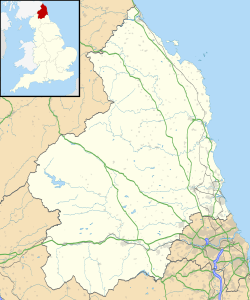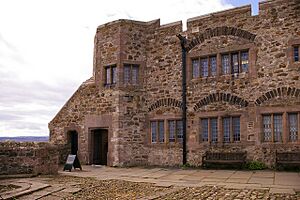Lindisfarne Castle facts for kids
Quick facts for kids Lindisfarne Castle |
|
|---|---|
| Holy Island, Northumberland, England | |

Lindisfarne Castle, a 16th-century fortification made into a family home by Sir Edwin Lutyens in 1901.
|
|
| Coordinates | 55°40′08″N 1°47′06″W / 55.669°N 1.785°W |
| Grid reference | NU135435 |
| Type | Castle |
Lindisfarne Castle is a historic building on Holy Island. This island is located near Berwick-upon-Tweed in Northumberland, England. The castle was first built in the 1500s. Later, in 1901, a famous architect named Sir Edwin Lutyens changed it a lot. You can reach Holy Island from the mainland by a special road called a causeway. This causeway is only open when the tide is low.
Contents
The Castle's Early History
The area where Lindisfarne Castle stands was once a very busy border. It was a place where England and Scotland often had conflicts. Also, Vikings frequently attacked this region a long time ago.
Why Was the Castle Built?
Before the castle, there was a religious building called Lindisfarne Priory. Around 1537, the priory was closed down. This happened during a time when King Henry VIII was closing many monasteries. After the priory closed, the king's soldiers used its old buildings to store naval supplies.
In 1542, King Henry VIII ordered that the site be made stronger. He wanted to protect it from possible attacks by Scotland. By 1547, the fort had several cannons. These included large guns like a demi-culverin and smaller ones like brass sakers.
Building on Beblowe Crag
In 1549, a small fort was built on a high rock. This rock is called Beblowe, and it's the highest point on the island. It's about one kilometer east of the old priory buildings. The fort was built there because it had a great view of the harbor.
Later, in 1565, an engineer named Sir Richard Lee checked the fort. He found it was not in good shape. So, Elizabeth I ordered more work to be done. Between 1570 and 1571, the fort was made much stronger. New platforms were added for the latest cannons. During this building work, stones from the old priory were used.
When the Castle Was Less Needed
When James I became king of both Scotland and England, the need for the castle changed. The two countries were no longer fighting each other. Even so, soldiers from Berwick still guarded the castle. It continued to protect the small Lindisfarne Harbour.
In the 1700s, some rebels briefly took over the castle. These rebels were called Jacobites. However, soldiers from Berwick quickly took it back. The rebels were captured but managed to escape. They hid near Bamburgh Castle before getting away.
In later years, the castle was used by the coastguard. It also started to become a popular place for tourists to visit.
Lutyens's Modern Makeover
In 1901, a wealthy publisher named Edward Hudson bought the castle. He owned Country Life magazine. Hudson hired Sir Edwin Lutyens to redesign the castle. Lutyens was a famous architect known for the Arts and Crafts style. This style focused on traditional craftsmanship and simple forms.
It's said that Hudson and Lutyens found the castle while exploring Northumberland. They climbed over a wall to look inside.
The Walled Garden
The castle also has a walled garden. This garden was originally a place where the soldiers grew vegetables. Lutyens's friend, Gertrude Jekyll, designed the garden. She was a very famous garden designer. She worked on the garden between 1906 and 1912.
The garden is a little distance from the castle itself. Between 2002 and 2006, the garden was restored. It now looks like Jekyll's original design.
New Owners and the National Trust
Hudson sold the castle in 1922 to a stockbroker named Oswald Toynbee Falk. Falk owned it for only a short time. He then sold it to Edward de Stein, a banker. Since 1944, the castle, its garden, and nearby lime kilns have been looked after by the National Trust. The National Trust is a charity that protects historic places. The castle is now open for visitors to explore.
Unique Boat Sheds
Lutyens used old, upside-down fishing boats as sheds. These boats were called herring busses. In 2005, two of these boat sheds were sadly destroyed by fire. They were replaced in 2006. The third boat shed has also been repaired by the National Trust.
A DVD called Diary of an Island shows how the new boat sheds were made. It shows a fishing boat being cut in half. Then, the two halves were brought to the island and lifted into place by a crane.
A Spanish architect named Enric Miralles was inspired by Lutyens's boat sheds. He used them as an idea for his design of the Scottish Parliament Building in Edinburgh.
The castle was closed for big renovation work from November 2016 to April 2018.
Exploring Inside the Castle
Getting into the castle is quite an adventure. You have to climb a steep path around the rocky base. Lutyens designed the path without railings or fences. He wanted to show how exposed the castle was to the elements. It's said that when the future George V and Queen Mary visited in 1908, they were worried about the steep, bumpy path.
Once inside, the entrance hall has large stone pillars. They might remind you a bit of a church. The dark reddish-brown stone contrasts with the white walls. The floor is made of bare stone.
The kitchen is also quite simple. It has a very large stone fireplace. Lutyens used the spaces in interesting ways throughout the castle. He used materials like stone, brick, and wood. This created a simple, rustic feel. Even though it's a castle, it feels like a cozy home.
In the scullery, there's a tiny window above a stone sink. Next to it, you can see the old machinery. This was used to operate the portcullis, a heavy gate that could be lowered to block the entrance.
Downstairs, you'll find the dining room. This part of the castle is inside the remains of the old Tudor fort. The arched ceilings here and in the next room are very strong. They support the gun battery above. The large fireplace has an old bread oven. Lutyens added Neo-Gothic style windows here. One wall is painted a deep blue, which looks striking against the red-brick floor.
Next to the dining room is the ship room. It has a green wall. The furniture is mostly dark wood. The few chairs and sofas have soft, faded colors.
The largest bedroom, called the east bedroom, is bright and airy. The long gallery was a new space created by Lutyens. It was designed to look like the grand halls in Elizabethan and Jacobean houses. It's smaller, but the stone arches and oak beams still give it a grand, rustic feel.
Further on, an upper gallery has a raised platform. From here, an oak door leads to the upper battery. This spot offers amazing views along the coastline. The music room in the castle was used by a famous cellist named Guilhermina Suggia. A cello is still kept in the room today to remember her visits.
{{wide image|Lindisfarne Castle panorama.jpg|1000 px|A wide view of Lindisfarne Castle.]]
Castle on Screen
Lindisfarne Castle has been a location for several films and TV shows. These include:
- Cul-de-sac (1966)
- The Tragedy of Macbeth (1971)
- Cold Feet (1998–2003)
- The Scarlet Pimpernel (1982)
- Wolfblood
- Reign
See also
 In Spanish: Castillo de Lindisfarne para niños
In Spanish: Castillo de Lindisfarne para niños
- Treasure Houses of Britain





